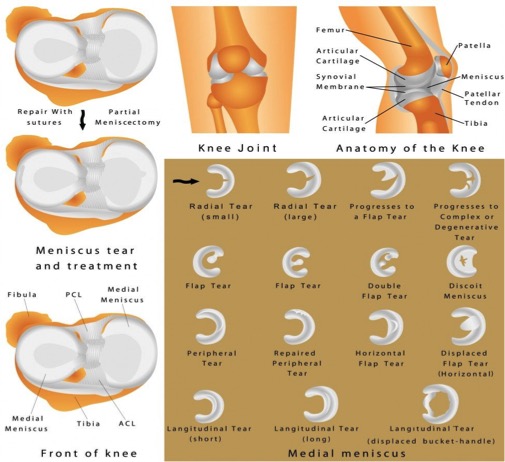WHAT IS A MENISCAL INJURY?
A meniscal tear occurs when the fibrocartilage disc, or cartilage, located within the knee joint is injured. There are two menisci in the knee and it is possible to injure either one or both.
The menisci can become injured via two mechanisms. The first is through degenerative change to the menisci where progressive wear of either meniscus occurs with age. The second mechanism of injury occurs more commonly in the athletic population and is the result of trauma to the knee.

ANATOMY OF THE MENISCUS
The meniscus, also known as the cartilage, is a fibrocartilagenous structure located in the knee between the femur and tibia. There are two menisci within the knee, termed the medial and lateral meniscus. The menisci are attached at the front and back of the knee via the anterior and posterior horn.
The menisci helps to increase the congruency of the knee joint, improve joint lubrication and absorb shock.
Multiple styles of meniscal tears are possible and are termed according to their orientation and severity. Styles of meniscal tears include degenerative, longitudinal, flap, bucket handle and radial tears.
WHAT ARE THE SYMPTOMS OF A MENISCAL INJURY?
The most common symptoms associated with meniscal injury include
- Knee swelling
- Pain along the joint line
- The sensation of locking, clicking or catching within the knee
- Restriction of knee movement
- Aggravation of symptoms by twisting the knee, particularly when standing on the leg.
DO I HAVE A MENISCAL INJURY?
Traumatic injury the menisci of the knee involves a twisting movement where the foot is planted on the ground and a rotation force is applied to the knee.
TREATMENT OF A MENISCAL INJURY?
PHYSIO MAINSTAY
For degenerative meniscal injuries an initial 6-8 week individualised exercise program is often justified. This program should focus on knee range of movement, lower limb muscle strength, aerobic capacity and proprioception. Small tears are also recommended to trial a period of individualised exercise for management. Physiotherapy management has been shown to be as effective for treating degenerative meniscus injury signs as surgery. Assessment of the joints above and below the knee, including the ankle and hip, should also occur to ensure appropriate load transfer is occurring throughout the lower limb.
ADJUNCT/ALTERNATE THERAPY OPTIONS
More extensive tears or traumatic tears that consistently limit your knee movement, result in increasing pain or are associated with other knee injuries may require arthroscopic surgery. The decision to have surgery can be made between you, your physiotherapist and an orthopaedic surgeon.
DIFFERENTIAL DIAGNOSIS:
Due to the mechanism of injury several other injuries to the knee must be assessed for, including:
- ACL or PCL injury
- Medial or lateral co-lateral ligament injury
- Patella dislocation
5 TIPS FOR SELF MANAGING OR FIXING YOUR MENISCAL INJURY
- If a suspected meniscus injury has occurred early icing can assist in reducing excessive swelling.
- Modify your activities to reduce the amount of twisting performed by the knee. Alternative cross training activities may be able to be completed instead of your usual exercise.
- Seek assessment from a physiotherapist to ensure other injuries are ruled out.
- Ensure you have good mobility and control of the ankle and hip joints to assist with shock absorption through the knee and a return to activity.
- Short term medication, when discussed with a medical practitioner, may be of assistance to reduce pain and swelling.
OTHER SELF HELP STRATEGIES
-
SLEEPING POSITIONS
In the early stages of injury you may find sleeping with a pillow under your knee or between your knees more comfortable.
-
SITTING POSITIONS
In the early stages of injury sitting with less knee bend and making sure the knee is not too rotated can assist in pain levels.
- RETURN TO ACTIVITY GOALS
For smaller tears or degenerative tears a conservative physiotherapy management program is recommended to ensure a safe return to activity. For a return to activity you should have good knee range, appropriate strength of the knee and surrounding joints and manageable knee pain.
If surgery is required a return to activities will take longer. This is variable and may take between two to eight weeks, depending on the severity of injury.
REFERENCES
Yim, J. et al (2013). A comparative study of meniscectomy and nonoperative treatment for degenerative horizontal tears of the medial meniscus. American Journal of Sports Medicine, 41 (7), 1565-1570.
Petersen, W. et al (2015). The treatment of non-traumatic meniscus lesions, systematic review. Deutches Arzteblatt International, 112 (42), 705-713.
Stensrud, S. et al (2015). Effect of exercise therapy compared with arthroscopic surgery on knee muscle strength and functional performance in middle-aged patients with degenerative meniscus tears: a 3-mo follow-up of a randomized controlled trial. American Journal of Physical Medicine & Rehabilitation, 94 (6), 460-473.
Sihvonen, R. et al (2017). Arthroscopic partial meniscectomy versus placebo surgery for a degenerative meniscus tear: a 2-year follow-up of the randomised controlled trial. Annals of Rheumatic Diseases, 9.
Need additional help
Our team at Physica are here to help you with all of your musculoskeletal conditions. Please book online using the link in the header or if you have additional questions prior to bookings contact us via email.
